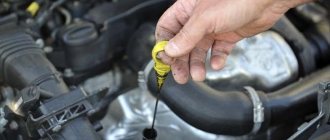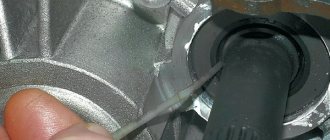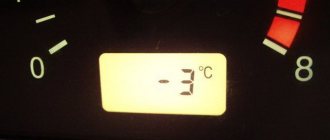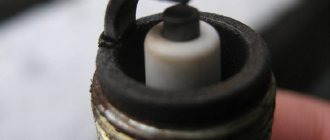VAZ 2110 8 valve injector stalls at idle - causes and solutions
The first VAZ-2110 was produced in 1995. At first it was equipped with a carburetor engine with 8 valves, and then only injection engines began to be installed on it. This model was produced in sedans, hatchbacks, and even station wagons. In 2007, they stopped being produced in Tolyatti, but began to be produced in Ukraine.
If a car suddenly stalls, it is always dangerous. It’s better not to allow this to happen, but if this has already happened, you need to look for the problem and solve it. In order to understand why the VAZ-2110 does not move without the help of car service specialists and wasting money, you need to have at least a little idea of which unit you need to look into, which sensors you need to check. There are many special thematic forums on the Internet where people discuss their cars and give each other advice on any problems. There you can find answers to your questions, and on YouTube you can also see it clearly.
Methods for diagnosing the idle air regulator (IAC)
The most common cause of the described problem, as well as the fact that the car cannot be started at all, is a malfunction of an engine part such as the idle air control. This happens most often on domestically produced cars. There are several possible situations where an IAC malfunction may occur. While the car is moving, a short-term stop occurs, as a result of which the engine stalls when hot immediately after it starts, or refuses to start at all.
After the engine has started, normal idle speed is restored only when the gas pedal is pressed at least once. Observation of similar behavior is possible with a cold engine. The initial attempt to start the engine is unsuccessful, normal operation is restored only after pressing the gas pedal.
In different situations, it may be enough to either press the pedal once or hold it until the engine warms up. An IAC malfunction may occur during sudden braking, when the engine stalls unexpectedly, and restarting shows a normal idle speed above 1500 and within 2000 rpm.
If this is the case with your car, you can try washing the IAC and throttle assembly using a special solution. If the problems do not go away, the idle air control will have to be replaced. Over time, some components may wear out naturally.
Incorrect engine operation at idle
More questions arise if the engine suddenly stalls at idle. There are several possible faults that could cause this type of problem. You can check all of them yourself in your garage.
The first thing to check is the idle speed sensor. Since it is connected to the engine, its incorrect readings can disrupt the system. It is worth checking that it is connected correctly and is working properly. The device must be replaced if there is damage to the housing.
It is very easy to check the functionality of the sensor:
No less problematic is the throttle valve assembly. If it is clogged, similar problems arise as when the fuel channels are clogged, and the engine sometimes stalls. Clean the throttle valve. If this does not solve the problem, check the condition of the throttle sensor. Its malfunction also leads to incorrect operation of the engine unit, so replacement or repair will help solve the problem.
GOOD TIPS
First, let's look at the reasons common to carburetor and injection fuel supply. That is, reasons beyond their control. Anyone who has looked for the causes of problems themselves knows that this is done by the method of elimination. But the law of meanness always works, and the reason is, as a rule, in the last node being checked. Therefore, let's turn to statistics and, based on its prompting, begin to implement the random method.
- Life practice shows that most often the cause is the fuel pump. Bleed the fuel pump and if it starts and runs, then that is the reason. It needs to be changed. Change spark plugs. A very common reason for the engine to stall. Even a beginner can cope with replacing spark plugs, so it is better to eliminate this reason immediately.
- If the car runs on a 16-valve injector and stalls, then you need to change the oxygen sensor; it is possible that it is not tightly connected to the connector located on the air filter housing. You should connect it correctly, if this does not help, then you should clean the injectors, since the gasoline now contains impurities, and the injectors become clogged.
- The reason that the engine stalls while driving may be the idle speed sensor (IAC), or more precisely, the idle speed controller (IAC). By the way, if there are problems with the IAC, the engine stalls even at idle. So, you should remove it and start by simply cleaning it. Don't forget to clean the mounting hole on the throttle assembly where the sensor needle goes. After cleaning, you need to check its serviceability. To do this, with the ignition on, bring the power block to the removed sensor; if the conical needle extends, then everything is in order with the sensor, but if not, then the sensor needs to be changed.
- If the engine is equipped with a carburetor, then the reason may be as follows - an idle fuel jet solenoid valve is installed in the upper part of the carburetor. You need to remove it and look at the clearance; if it is clogged, then clean it. Very often this is what causes the car to stall. The reason may also be in the carburetor itself - the fuel supply shut-off needle of the float chamber sometimes jams, not providing the required amount of fuel. Or it may be that it does not close and this leads to fuel overflow. In both cases, the car stalls hopelessly.
- The reason that the car stalled while driving may be due to wear on the rollers or timing belt. In both cases, you need to contact a specialist. This is a serious knot. Giving absentee advice regarding the repair of this unit is, to say the least, irresponsible.
- When you start the car when it's hot, the engine stalls. The crankshaft sensor may need to be replaced. It is possible that the catalyst burned out and a plug formed in the exhaust system.
Troubleshooting options
It is clear that if any emergency situations arise with the motor, it is advisable to contact a specialized service. However, this procedure is not always possible. Therefore, it is worth knowing how to independently diagnose the main systems and key parts.
Throttle valve and assembly
When the speed drops at idle and the car stalls, you need to pay close attention to the details of the throttle assembly. Long-term operation of the car on low-quality fuel and untimely maintenance of the air filter can lead to malfunctions of the throttle valve. It periodically jams if debris gets into the equipment.
Throttle valve VAZ 2112
The problem can be solved by cleaning the system. The throttle is cleaned using carburetor cleaners. Using a compressor, you need to blow out the damper under the pressure of compressed air. It is not recommended to touch the screws located inside and on the side. If cleaning does not correct the situation, the device must be replaced. This operation is not particularly difficult.
Crankcase malfunction
There is an oil trap in the crankcase ventilation system of the engine. Its contamination can also lead to interruptions in engine operation. Crankcase gases do not allow the engine to function normally, the speed fluctuates, the internal combustion engine stalls.
Sensors
If a gasoline car stalls at idle, then one of the sensors is likely to break. In injection cars with an electronic engine control system, the engine usually starts normally, but then it stops working. It's worth checking here:
- Electronic car indicators;
- DRХХ – device that regulates idle speed;
- Air flow meter (air intake in the carburetor);
- Sensor indicating the position of the throttle curtain.
Electronic control unit in VAZ 2114
Interruptions in the operation of any sensors immediately affect the behavior of the electronics - errors appear in the car control unit. The “brains” of the machine receive unreliable information. It is not transmitted correctly to the engine. It starts working with parameters that do not correspond to reality. Self-testing of this device is not possible. You need to contact a professional for service.
Diagnostics of mass air flow sensor
The idle air control device is usually to blame for engine malfunction when the car idles poorly. But you pressed the gas pedal and the engine started. In the latest VAZ modifications, error information appears on the instrument panel.
When diagnosing, you must use a multimeter. If a part is faulty, it is recommended to replace it with a new one. All sensors are reasonably priced. It is better to start checking with parts that have a simpler design. Then gradually move on to complex devices. We must not forget that the problem may lie not only in the sensors themselves. It is also necessary to check the wiring to them and the presence of stable contact.
Carburetor
If the VAZ carburetor stalls at idle speed, then the jets may become clogged. Low-quality gasoline, deposits from the gas tank, contain small particles of debris. They can easily disrupt the operation of the fuel injection system. It is worth replacing the filter in front of the carburetor and cleaning the device itself. The dispensing part is cleaned using a cleaning solvent, which is sold in aerosol cans. Another reason is often a prolonged lack of carburetor adjustment.
In a mechanical fuel pump of carburetor cars, the filter mesh may be clogged with dirt. This reduces the performance of the device. Wear of the membrane and its destruction often leads to clogged carburetor channels.
GOOD TIPS
First, let's look at the reasons common to carburetor and injection fuel supply. That is, reasons beyond their control. Anyone who has looked for the causes of problems themselves knows that this is done by the method of elimination. But the law of meanness always works, and the reason is, as a rule, in the last node being checked. Therefore, let's turn to statistics and, based on its prompting, begin to implement the random method.
- Life practice shows that most often the cause is the fuel pump. Bleed the fuel pump and if it starts and runs, then that is the reason. It needs to be changed. Change spark plugs. A very common reason for the engine to stall. Even a beginner can cope with replacing spark plugs, so it is better to eliminate this reason immediately.
- If the car runs on a 16-valve injector and stalls, then you need to change the oxygen sensor; it is possible that it is not tightly connected to the connector located on the air filter housing. You should connect it correctly, if this does not help, then you should clean the injectors, since the gasoline now contains impurities, and the injectors become clogged.
- The reason that the engine stalls while driving may be the idle speed sensor (IAC), or more precisely, the idle speed controller (IAC). By the way, if there are problems with the IAC, the engine stalls even at idle. So, you should remove it and start by simply cleaning it. Don't forget to clean the mounting hole on the throttle assembly where the sensor needle goes. After cleaning, you need to check its serviceability. To do this, with the ignition on, bring the power block to the removed sensor; if the conical needle extends, then everything is in order with the sensor, but if not, then the sensor needs to be changed.
- If the engine is equipped with a carburetor, then the reason may be as follows - an idle fuel jet solenoid valve is installed in the upper part of the carburetor. You need to remove it and look at the clearance; if it is clogged, then clean it. Very often this is what causes the car to stall. The reason may also be in the carburetor itself - the fuel supply shut-off needle of the float chamber sometimes jams, not providing the required amount of fuel. Or it may be that it does not close and this leads to fuel overflow. In both cases, the car stalls hopelessly.
- The reason that the car stalled while driving may be due to wear on the rollers or timing belt. In both cases, you need to contact a specialist. This is a serious knot. Giving absentee advice regarding the repair of this unit is, to say the least, irresponsible.
- When you start the car when it's hot, the engine stalls. The crankshaft sensor may need to be replaced. It is possible that the catalyst burned out and a plug formed in the exhaust system.
Why does the VAZ-2112 stall while driving? We know!
There may be several reasons for such a malfunction, which have the same symptoms and different ways to eliminate them. We will tell you about the most common ones that are found on the VAZ-2112, and we will tell you how to fix them.
Throttle valve
Inspect this element for traces of carbon deposits and clean it with carburetor cleaner. To achieve the best effect, work should be carried out on a dismantled element.
Throttle position sensor
A small element attached to the throttle body is also the cause of engine failure with such symptoms on VAZ-2112 cars. The thing is that when the throttle position sensor is faulty, it is not able to transmit the command to open idle in time. Thus, the system thinks that the driver continues to press the gas pedal, making the air supply minimal. Based on this, the engine simply stalls at idle and starts again after turning the key again.
The sensor is located here
Ignition system
Pay attention to the condition of the ignition module (article on module repair here), high-voltage wires and spark plugs. If there are traces of corrosion, melting on their surface, or there are cracks on the body, this will only mean that each of the above elements will require replacement, since they cannot be repaired or corrected. In order to correctly approach the issue of choosing spark plugs for the VAZ-2112, you can read this article.
First we check the wires, and then the spark plugs.
Supply system
In this case, check all the wires coming from the battery, generator and ECU. Since even the slightest short to ground of the power wires can shut down the engine.
Fuel pump and grid
It is possible that a large amount of deposits has formed on the mesh, which is located directly in the gas tank, and while driving the required amount of fuel simply does not reach the engine, the gas pump does not pump with the required force, which causes the engine to stall. The fuel pump screen needs to be cleaned or replaced.
The difference between the new grid and the old one.
Idle speed sensor close up on an editorial VAZ-2112
Although such a cause of malfunction is not inherent in this sensor, if it has not been checked for a long time, it should not be ignored. If there are deposits on it, then it should be cleaned; if there is mechanical damage, then replace it. How to do this correctly is written in this article.
How to check the serviceability of the throttle position sensor
One of the problems may also be faulty operation of the DPZD. It is this part that is tested last, since the problems described above often arise. However, you should not ignore testing this sensor, because sometimes it helps save a lot of time.
Here's how to do it correctly:
- This sensor is located on the throttle pipe and is connected to the throttle axis. Secured with two screws. When removing the sensor, you should pay attention to the condition of the throttle valve, whether it is coked. If it does, then it will have the same symptoms as with problems arising with the sensor, but it can be checked even without removal.
- To do this, you need to measure the voltage at the DPSD terminals when the ignition is turned on. It should not be higher than 4B.
- Then you need to check the voltage at the DPSD terminals while the damper is moving. There should be no changes to it. If there are sudden changes, this indicates that the sensor is faulty.
When you find out that the sensor is faulty, you need to replace it with a new one. Do not spare money on a new part, because all this affects the operation of the car, and therefore your health. The VAZ-2110 is usually equipped with two types of DPZD. The first is film-resistive, the second is non-contact. The first one can withstand 55 thousand mileage, and the second one works indefinitely, but the price is much more expensive than the first one.
Now you know what to do if your VAZ-2110 stalls and how to deal with the problems without resorting to the help of professionals and wasting money. We hope that our advice will be useful to you in a difficult situation.
If the engine does not start: troubleshooting methods
If the most unpleasant thing happens, you should not make useless attempts and only discharge the battery by rotating the crankshaft. You may still need a charge of electricity if you succeed in repairing the car. At least for the starter to work.
First of all, you need to check whether the fuel pump is working , whether there is enough fuel, whether the ignition works. Maybe the problem is in the injectors that have failed, but this happens very rarely. Their O-rings, vacuum hoses, and gaskets wear out more often. The same goes for the electronic control unit (ECU), for the most part it works properly for a long time.
The fuel pump and its operation are controlled by sound . If it is missing, it is important to ensure that the wiring is in good condition. The sufficient voltage supplied to the fuel pump is 12 V. The pressure created during its operation by the fuel supply system should be about 2-3 bar.
When fuel stops flowing, the pressure drop occurs over time, not immediately. If this happens almost immediately, then you need to check the fuel regulator, unless, of course, it is leaking. You can turn off the fuel pressure regulator for a short time to make sure the system is working.
To check the ignition, the spark plug is connected to the ground as carefully as possible so that the computer does not burn out. The condition of the spark plugs can cause the car to stall while driving, but this happens quite rarely. The integrity of the wiring and shielding play a big role in the performance of the synchronization sensor and when testing it.
All connections that may affect the operation of the computer should be checked . There is a good chance that there is a disconnect somewhere. In this case, a good signal of operability is the illumination of the Check Engine indicator. If it exists, then there is still hope. However, cars produced by VAZ do not allow you to determine the error code and, accordingly, localize the fault without using a tester.
A large number of errors most likely indicates a completely detached part. Next, you should measure the voltage supplied to the network. Typically, a running engine consumes 14 V, its cranking results in a voltage of 8 V, and an idle one - 12.5 V. You should definitely make sure that the drive belt and camshaft are intact, which will not be very difficult.
Finally, you should completely disconnect everything from the ECU except the crankshaft timing sensor, but if you do not understand the actions being performed, it is better not to risk it. If the VAZ 2110 stalls after the work done above, you need to check how clogged the air filter is. If it has not been replaced or cleaned for a long time, it is better to do it right now.
It wouldn’t hurt to check the fuel pump, as mentioned earlier, compare the actual coolant temperature with the sensor readings (a deviation of 5 °C is allowed), as well as the voltage. In addition, it is worth wiggling the various connectors. This may seem funny and absurd, but it happens that the reason is precisely a poor connection. Finally, you should inspect the camshaft belt.
Almost all drivers can perform the list of actions described. There may be several reasons why the VAZ 2110 stalls while driving, and not all of them are easily identified. Simply moving the wires can help, and in some cases you will need to go to a car service center if simple steps do not help solve the problem and prevent its further manifestations.
Didn't find the information you are looking for? on our forum.
Good advice
First, let's look at the reasons common to carburetor and injection fuel supply. That is, reasons beyond their control. Anyone who has looked for the causes of problems themselves knows that this is done by the method of elimination. But the law of meanness always works, and the reason is, as a rule, in the last node being checked. Therefore, let's turn to statistics and, based on its prompting, begin to implement the random method.
- Life practice shows that most often the cause is the fuel pump. Bleed the fuel pump and if it starts and runs, then that is the reason. It needs to be changed.
- Change spark plugs. A very common reason for the engine to stall. Even a beginner can cope with replacing spark plugs, so it is better to eliminate this reason immediately.
- If the car runs on a 16-valve injector and stalls, then you need to change the oxygen sensor; it is possible that it is not tightly connected to the connector located on the air filter housing. You should connect it correctly, if this does not help, then you should clean the injectors, since the gasoline now contains impurities, and the injectors become clogged.
- The reason that the engine stalls while driving may be the idle speed sensor (IAC), or more precisely, the idle speed controller (IAC). By the way, if there are problems with the IAC, the engine stalls even at idle. So, you should remove it and start by simply cleaning it. Don't forget to clean the mounting hole on the throttle assembly where the sensor needle goes. After cleaning, you need to check its serviceability. To do this, with the ignition on, bring the power block to the removed sensor; if the conical needle extends, then everything is in order with the sensor, but if not, then the sensor needs to be changed.
- If the engine is equipped with a carburetor, then the reason may be as follows - an idle fuel jet solenoid valve is installed in the upper part of the carburetor. You need to remove it and look at the clearance; if it is clogged, then clean it. Very often this is what causes the car to stall.
- The reason may also be in the carburetor itself - the fuel supply shut-off needle of the float chamber sometimes jams, not providing the required amount of fuel. Or it may be that it does not close and this leads to fuel overflow. In both cases, the car stalls hopelessly.
- The reason that the car stalled while driving may be due to wear on the rollers or timing belt. In both cases, you need to contact a specialist. This is a serious knot. Giving absentee advice regarding the repair of this unit is, to say the least, irresponsible.
- When you start the car when it's hot, the engine stalls. The crankshaft sensor may need to be replaced. It is possible that the catalyst burned out and a plug formed in the exhaust system.
The list of supposed reasons can be continued indefinitely and one cannot find a reason why the VAZ-2110 stalls while driving, regardless of whether the injector supplies fuel or the carburetor. But this is not a reason to give up. The road can be mastered by anyone walking or driving, you just need to fix the problems in the car. We can say for sure that what will not help you start the engine is kicking innocent wheels and calling the car’s mother an unkind word. Remember, he doesn’t have a mother, he’s half orphan. Please be understanding about this.
Fuel pump
Due to a faulty fuel pump, the car may operate normally for a while, then stall. Interruptions begin in the mechanism, fuel does not enter the chambers or arrives in small quantities. Initially, the engine will run at idle, as the speed increases, it will stall, and when the pump finally fails, it will not start.
The fuel pump is easy to repair, but the breakdown may recur, so it is better to replace it. This unit is located under the rear seat.
In summer, the fuel pump may operate intermittently due to fuel boiling. This happens on classic Soviet cars. To get rid of the problem, you have to turn off the engine and wait until the fuel cools down.
RPM drops slowly
Post edited by Temosha: 02/21/2008 – 21:02
- At work
- Group: Users
- Messages: 22,153
| QUOTE (Temosha @ Feb 21 2008, 19:54) |
| The question is primarily for UP. The check light doesn't come on, the car drives great. WHAT COULD BE. One of my thoughts is that the injectors need to be cleaned. I pour fuel 95 |
- The best car is YOURS.
Testing the mass air flow sensor (MAF)
Let us remind you what we are talking about - VAZ-2110 8-valve injector: the speed drops and stalls. A reasonable question arises: what to do? If the reason is not the IAC, then it is worth testing the mass air flow sensor. Here are some recommendations on how to do this:
- Disconnect the sensor connector from the on-board system. The controller that controls the engine will operate in emergency mode, but for short testing this is not fatal. If your car runs much faster, then the problem is most likely in the mass air flow sensor. It's time to clean it.
- Replace the sensor with a working one, and then see how the engine works. There are improvements, which means you need to either clean or replace your own mass air flow sensor.
- It also makes sense to inspect the air intake; to do this, you need to remove the mounting clamp and carefully inspect the inside of the air intake, there should be no condensation or oil there. If any are found, then it will have to be cleaned with special means.
- You can also test the mass air flow sensor using a multimeter. To do this, you need to switch the multimeter to voltmeter mode and set it to 2. The sensor has 2 wires - yellow and green. Yellow transmits a signal to the controller, and green transmits a signal to ground. When the ignition is turned on, we take measurements between these two wires. The engine should not be running. If the readings are in the range of 1.01-1.02, then the sensor is in perfect order. Readings in the range of 1.02-1.03 – it’s time to clean the sensor. And if the indicators go off scale to 1.04, then it’s time to get a new sensor.
Now we have figured out the main symptoms of a malfunction of the mass air flow sensor; neither testing nor troubleshooting is particularly difficult. It is quite possible to cope without after-sales service.
Why does the car stall when braking: the main reasons for the engine stopping
Many car enthusiasts, when starting the engine, believe that it works without any problems and immediately gains the necessary characteristics for uninterrupted operation. After a short warm-up, the car starts normally, but when braking, it stalls, most often at the moment when the clutch is depressed.
To understand the situation, just look at the tachometer or listen to the sound of the engine. When you press the clutch, the speed drops abruptly to a minimum level at which the engine stalls. Moreover, such a problem may occur only occasionally, which complicates the identification of the malfunction. The engine may stall when braking without pressing the clutch, or simply when braking the engine.
From this we can conclude that the car stalls in transient modes when the gas pedal is released and the throttle valve closes. At this moment, the idle system begins to work, but this does not mean that it alone is responsible for the problem that has arisen.
If the car stalls while braking, the first thing to check is the condition of the braking system. To do this, you need to pump the pedal five to six times and leave it depressed to the bottom point. This is done with the engine off, after which it starts, and the pedal should rise to its normal functional state, and the brakes should engage normally. If this does not happen, the brake system needs to be diagnosed and repaired.
Experts include the following reasons why the engine stalls when braking:
- breakdown of the brake vacuum booster, its depressurization;
- a burst and depressurized vacuum booster hose;
- in engines with fuel injection, the idle speed sensor may fail;
- failure or problems with adjusting the throttle position sensor or its clogging;
- tank clogging or fuel pump failure.
Breakdown of the vacuum brake booster (VUT)
This unit reduces the force exerted by the driver's foot on the brake pedal. It is located in front of the master cylinder and consists of a vacuum hose and an intake manifold. Its design includes a flexible membrane or VUT diaphragm. With fast and sharp braking, even microscopic depressurization of the vacuum booster leads to problems.
During operation, the membrane periodically moves back and forth. As a result of wear, it stretches in the middle part and cracks, allowing air to pass through. It is no longer able to create a vacuum, and air enters the fuel mixture, disturbing its balance. To identify problems with the diaphragm, you will need to do several simple procedures:
- Turn off the engine.
- Press the brake pedal up to 6 times, “pumping” it, with each new press the pedal stroke should become tighter.
- Keep the pedal pressed and start the car engine.
- If the pedal “falls through” when the engine is running, the brake booster works normally; if the pedal does not respond, this is a sign of a ruptured membrane, and the problem must be solved urgently.
The serviceability of the VUT diaphragm can be checked in another simple way:
- the car starts and runs for several minutes, then the brake pedal is pressed;
- the car engine turns off;
- it is held pressed for at least half a minute;
- the pedal must remain pressed and not try to rise, but if it rises or resists your foot, the vacuum booster of the brake system is faulty.
Video: What to do if the engine stalls when you press the brake pedal? (Do it yourself repair)
Depressurization of the vacuum booster hose
This hose serves to connect the amplifier to the intake manifold. Violation of its integrity may cause the engine to stall during sudden braking. As a result of wear or mechanical damage, cracks appear in the hose, into which air enters. The result is a violation of the proportion of the air-fuel mixture for the engine, for which the intake manifold is responsible. When you press the brake, especially sharply, it becomes critically lean, the engine speed drops and it stalls.
Checking the hose is quite simple. It is disconnected directly from the VUT, the car starts, and the hole is tightly closed with a finger. If the hose is intact, the engine speed will increase noticeably; if breaks and cracks appear, it will continue to suck in air and the speed will remain at the same level.











